1,2-二氨基蒽醌
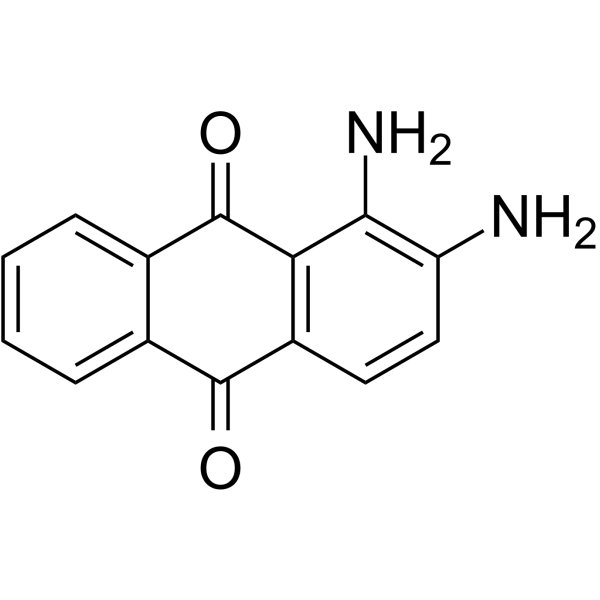
1,2-二氨基蒽醌结构式

|
常用名 | 1,2-二氨基蒽醌 | 英文名 | 1,2-DIAMINOANTHRAQUINONE |
|---|---|---|---|---|
| CAS号 | 1758-68-5 | 分子量 | 238.24100 | |
| 密度 | 1.456 g/cm3 | 沸点 | 548.8ºC at 760 mmHg | |
| 分子式 | C14H10N2O2 | 熔点 | 289-291 °C(lit.) | |
| MSDS | 中文版 美版 | 闪点 | 285.7ºC | |
| 符号 |

GHS07 |
信号词 | Warning |
1,2-二氨基蒽醌用途1,2-二氨基蒽醌是一种灵敏、特异、无毒的一氧化氮(NO)荧光探针。1,2-二氨基蒽醌可用于检测活细胞和动物中的NO生成,最大吸收波长约为540nm,NO的检测限为5μM[1][2]。 |
| 中文名 | 1,2-二氨基蒽醌 |
|---|---|
| 英文名 | 1,2-diaminoanthraquinone |
| 中文别名 | 1,2-二氨基萘醌 | 1,2-二氨基-9,10-蒽二酮 |
| 英文别名 | 更多 |
| 描述 | 1,2-二氨基蒽醌是一种灵敏、特异、无毒的一氧化氮(NO)荧光探针。1,2-二氨基蒽醌可用于检测活细胞和动物中的NO生成,最大吸收波长约为540nm,NO的检测限为5μM[1][2]。 |
|---|---|
| 相关类别 | |
| 体外研究 | 1,2-二氨基蒽醌及其与NO、DAA-TZ反应生成的产物可以使用荧光光谱和共焦显微镜进行光谱解析[1]。免疫荧光[1]细胞系:原始264.7巨噬细胞浓度:27.4μM孵育时间:20分钟结果:在细胞内有氧环境中与NO反应生成DAA-TZ。 |
| 参考文献 |
| 密度 | 1.456 g/cm3 |
|---|---|
| 沸点 | 548.8ºC at 760 mmHg |
| 熔点 | 289-291 °C(lit.) |
| 分子式 | C14H10N2O2 |
| 分子量 | 238.24100 |
| 闪点 | 285.7ºC |
| 精确质量 | 238.07400 |
| PSA | 86.18000 |
| LogP | 2.78880 |
| 蒸汽压 | 4.26E-12mmHg at 25°C |
| 折射率 | 1.757 |
| 储存条件 | 密封贮藏,储存在阴凉、干燥的地方 |
| 稳定性 | 常温常压稳定;避免与氧化物接触 |
| 分子结构 | 1、 摩尔折射率:67.14 2、 摩尔体积(m3/mol):163.6 3、 等张比容(90.2K):490.7 4、 表面张力(dyne/cm):80.9 5、 介电常数(F/m):无可用 6、 极化率(10 -24cm 3):26.61 |
| 计算化学 | 1.疏水参数计算参考值(XlogP):2.1 2.氢键供体数量:2 3.氢键受体数量:4 4.可旋转化学键数量:0 5.互变异构体数量:14 6.拓扑分子极性表面积86.2 7.重原子数量:18 8.表面电荷:0 9.复杂度:382 10.同位素原子数量:0 11.确定原子立构中心数量:0 12.不确定原子立构中心数量:0 13.确定化学键立构中心数量:0 14.不确定化学键立构中心数量:0 15.共价键单元数量:1 |
| 更多 | 1. 性状:黑色固体 2. 密度(g/mL, 20 ºC):未确定 3. 相对蒸汽密度(g/mL,空气=1):未确定 4. 熔点(ºC):289-291 5. 沸点(ºC,常压):未确定 6. 沸点(ºC,5.2kPa):未确定 7. 折射率(n 20/D ):未确定 8. 闪点(ºC):未确定 9. 比旋光度(º):未确定 10. 自燃点或引燃温度(ºC):未确定 11. 蒸气压(kPa,25ºC):未确定 12. 饱和蒸气压(kPa,60ºC)未确定: 13. 燃烧热(KJ/mol):-未确定 14. 临界温度(ºC):未确定 15. 临界压力(KPa):未确定 16. 油水(辛醇/水)分配系数的对数值:未确定 17. 爆炸上限(%,V/V):未确定 18. 爆炸下限(%,V/V):未确定 19. 溶解性:与水不溶解 |
|
1,2-二氨基蒽醌毒理学数据: 1、急性毒性:兔腹腔LD50:2700mg/kg;小鼠静脉LD50:320mg/kg。 2、致突变性 微生物鼠伤寒沙门氏菌突变测试系统:100μg/plate。 1,2-二氨基蒽醌生态学数据: 通常对水是不危害的; |
| 符号 |

GHS07 |
|---|---|
| 信号词 | Warning |
| 危害声明 | H315-H319-H335 |
| 警示性声明 | P261-P305 + P351 + P338 |
| 个人防护装备 | dust mask type N95 (US);Eyeshields;Gloves |
| 危害码 (欧洲) | Xi: Irritant; |
| 风险声明 (欧洲) | R36/37/38 |
| 安全声明 (欧洲) | S26-S37/39 |
| 危险品运输编码 | NONH for all modes of transport |
| WGK德国 | 3 |
| RTECS号 | CB6200000 |
| 海关编码 | 2922399090 |
| 1,2-二氨基蒽醌上游产品 10 | |
|---|---|
| 1,2-二氨基蒽醌下游产品 7 | |
| 海关编码 | 2922399090 |
|---|---|
| 中文概述 | 2922399090 其他氨基醛、氨基酮及其盐(包括氨基醌及其盐,但含有一种以上含氧基的除外). 增值税率:17.0% 退税率:9.0% 监管条件:无 最惠国关税:6.5% 普通关税:30.0% |
| 申报要素 | 品名, 成分含量, 用途, 乙醇胺及其盐应报明色度, 乙醇胺及其盐应报明包装 |
| Summary | 2922399090 other amino-aldehydes, amino-ketones and amino-quinones, other than those containing more than one kind of oxygen function; salts thereof VAT:17.0% Tax rebate rate:9.0% Supervision conditions:none MFN tariff:6.5% General tariff:30.0% |
|
[Detection of NO-synthase activity of lactobacilli by fluorescent staining].
Mikrobiologiia 76(4) , 570-2, (2007)
|
|
|
Spatial nitric oxide imaging using 1,2-diaminoanthraquinone to investigate the involvement of nitric oxide in long-term potentiation in rat brain slices.
Neuroimage 15(3) , 633-9, (2002) Long-term potentiation (LTP), a model of activity-dependent synaptic plasticity, involves the persistent enhancement of excitatory neurotransmission. Several recent studies have suggested a critical r... |
|
|
Floral transition and nitric oxide emission during flower development in Arabidopsis thaliana is affected in nitrate reductase-deficient plants.
Plant Cell Physiol. 49(7) , 1112-21, (2008) The nitrate reductase (NR)-defective double mutant of Arabidopsis thaliana (nia1 nia2) has previously been shown to present a low endogenous content of NO in its leaves compared with the wild-type pla... |
| EINECS 217-156-2 |
| 1,2-diamino-9,10-anthraquinone |
| 1,2-diaminoanthracene-9,10-dione |
| 1,2-diamino-anthraquinon |
| DAA |
| MFCD00001219 |
| 1,2-Diaminoanthraquinone |
| 1,2-diamino-10-anthracenedione |
| diamino-anthraquinone |
| 10-Anthracenedione,1,2-diamino-9 |

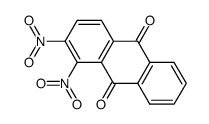 CAS号57875-61-3
CAS号57875-61-3 CAS号56250-79-4
CAS号56250-79-4![3-dimethylaminoanthra[1,9-c,d]isoxazol-6-one结构式](https://image.chemsrc.com/caspic/492/83206-52-4.png) CAS号83206-52-4
CAS号83206-52-4 CAS号62468-69-3
CAS号62468-69-3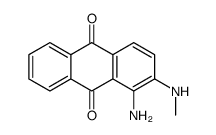 CAS号62468-68-2
CAS号62468-68-2![3-diethylaminoanthra[1,9-c,d]isoxazol-6-one结构式](https://image.chemsrc.com/caspic/454/83206-53-5.png) CAS号83206-53-5
CAS号83206-53-5![3-amylaminoanthra[1,9-c,d]isoxazol-6-one结构式](https://image.chemsrc.com/caspic/124/70730-79-9.png) CAS号70730-79-9
CAS号70730-79-9![6H-anthra[1,9-cd]isoxazol-6-one结构式](https://image.chemsrc.com/caspic/407/70730-89-1.png) CAS号70730-89-1
CAS号70730-89-1![3-bromo-6H-anthra[1,9-cd]isoxazol-6-one结构式](https://image.chemsrc.com/caspic/014/70730-91-5.png) CAS号70730-91-5
CAS号70730-91-5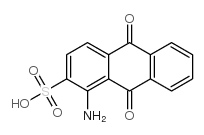 CAS号83-62-5
CAS号83-62-5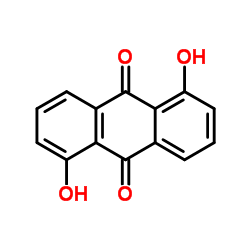 CAS号117-12-4
CAS号117-12-4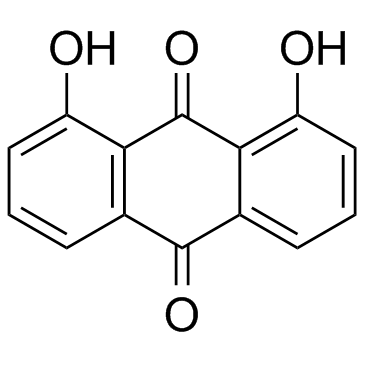 CAS号117-10-2
CAS号117-10-2![9,10-Anthracenedione,1,4-bis[(2-oxiranylmethyl)amino]-结构式](https://image.chemsrc.com/caspic/136/78146-26-6.png) CAS号78146-26-6
CAS号78146-26-6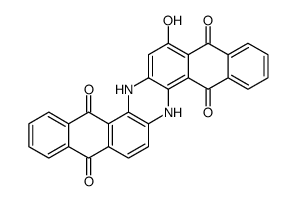 CAS号67905-10-6
CAS号67905-10-6![2,3-dimethylnaphtho[3,2-f]quinoxaline-7,12-dione结构式](https://image.chemsrc.com/caspic/118/89986-91-4.png) CAS号89986-91-4
CAS号89986-91-4![2,3-dihydroxy-naphth[2,3-f]quinoxaline-7,12-dione结构式](https://image.chemsrc.com/caspic/312/6259-70-7.png) CAS号6259-70-7
CAS号6259-70-7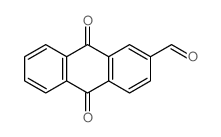 CAS号6363-86-6
CAS号6363-86-6
